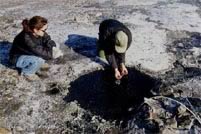Permafrost Springs on Earth and Mars
by Chris McKay
 |


Jen and Dale at Little Black Pond spring on Axel Heiberg Island
(click for larger image)
 |
Recent images from the camera on Mars Global
Surveyor show evidence recent liquid water outflows in the
Southern Hemisphere. These flow features occur on surfaces
with no craters, and in one case the flow crosses a sand dune.
Thus the water must have flowed fairly recently: less than a
million years ago. This is recent enough that the liquid water
must have flowed under the same climatic conditions we see
on Mars today. How
can liquid water flow
when the average
surface temperatures
is -60 C and there is
permafrost extending
for many kilometers
depth. It is not the
case that these flow
features are driven by
volcanos since they
are not located near
any of the martian
volcanic features.
One part of the
solution to this
puzzle may be found on Earth in the Canadian Arctic. There
are two sets of perennial springs located on Axel Heiberg
Island that flow through 600 m of permafrost and these springs
are not associated with any volcanic heat sources. Located at
nearly 80N these are the most poleward springs known, and
to our knowledge the only example of cold springs in thick
permafrost.
Axel Heiberg Island is mostly bare ground, with less
than 35% covered by glaciers or ice caps. The average air
temperature at the springs sites is approximately -17C. The
two springs both discharge a brine with measured discharge
temperatures that range from -2 to +6.5 C and remain constant
throughout the year despite air temperatures that fall well
below -40C. Flow rates are also constant with little variation.
We think that the springs are the results of a
subsurface salt aquifer. Water enters and leaves this salt
reservoir by way of the salt domes which reach the
surface. The water flows down into the salt dome from
a large lake - Phantom Lake - that sits on top of one of the
surface salt deposits at high elevation. After flowing
through the salt to deep underground, the current seeps
back up through the salt to the surface, forming a spring.
The Arctic springs demonstrate that liquid water
is capable of reaching the
surface in regions of thick,
continuous permafrost
without strong volcanic
heating sources. This
could have happened on
Mars. However the
question of the source of
the water on Mars
remains unclear. In the
Arctic the source of the
water is essentially
summer glacial meltwater
conveniently stored in a
large lake that happens to
sit on a salt structure at
high elevation. So in the Arctic there is a constant supply
of water and a hydrostatic pressure to drive the flow.
For Mars this is obviously not the case. The water must
be a remnant of an early period or recently melted ice or
both. Where did the water come from and why did it
flow recently? We donít know. Mysteries remain and
until we can get to Mars studies of water flow and springs
in the Arctic may provide us with our best clues.
This work is done by a team lead by Wayne Pollard
of McGill University and this year the field team included
Dale Andersen, Chris McKay, Jen Heldmann, and
Margarita Marinova.
| 
